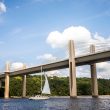Redesigning main street
Winsted, Conn., completed a streetscape redevelopment project this summer that is helping attract business investment downtown. The $1.8 million project is the first step in the city’s plans to revitalize its core and improve the local economy.
For several decades, Winsted has suffered economically. Situated on the banks of the Mad River, the city thrived as a mill town in the late 1800s. A catastrophic flood in 1955 officially ended the city’s mill town economy, which had been steadily declining since the early 1900s. Several mills were destroyed in the flood, leaving many residents unemployed and devastated. Today, the city continues to have one of the lowest per capita incomes in the state and a high unemployment rate.
The city’s economy was not helped much when the state widened the city’s main street, Route 44, from a two-lane to a four-lane road following the Mad River flood. With two lanes in both directions, a high speed limit, wide shoulders and uncontrolled parking, automobiles sped past Winsted’s two-mile-long downtown. Additionally, the state built a retaining wall on the river side of the road and situated parking against the wall. To visit the downtown stores and restaurants, pedestrians would have to cross the dangerously wide road without the help of controlled crosswalks. As a result, few travelers stopped in the city on their way through Connecticut.
In the late 1990s, city leaders learned about other small cities that had received federal TEA-21 grants to improve streetscapes on state roads. Winsted followed that lead and received a $1.4 million grant in 1999 to improve the Route 44 streetscape. “Getting a streetscape project approved, we thought, would be a catalyst to get some pedestrians downtown, slow some traffic down and help occupy some of the storefronts again,” says Ray Carpentino, Winsted’s director of community planning and development.
Meriden, Conn.-based BL Companies was hired to redesign a half-mile of Route 44 along the town’s main street to slow down traffic, and create a streetscape that would be more attractive and pedestrian friendly. The firm collected ideas from residents for the new streetscape design and worked with the state Department of Transportation to gain final approval. The resulting design called for narrower traffic lanes (11 feet wide), a landscaped seven-foot-wide median, stamped concrete crosswalks, recessed parking, decorative lighting and segments of sidewalk along the river.
Using Bridgeport, Conn.-based Waters Construction to build the new streetscape, the city had its own staff members and resident volunteers administer construction contracts and inspect the construction process. Completed this summer, the half-mile streetscape project has sparked several other downtown revitalization efforts, including a façade grant program that is helping business owners spruce up the buildings along Route 44. The city received $320,000 from the Connecticut State Bond Commission for the façade program, in which it grants up to $29,000 for each project. As a result, 28 storefronts have been rehabilitated, spurring more than $750,000 in improvements since April 2003.
The city also has received $1 million from the Washington, D.C.-based Environmental Protection Agency for environmental assessments and brownfield cleanups. By this summer, eight of 12 vacancies in downtown buildings were filled. Recently, the town and its non-profit downtown revitalization organization, Friends of Main Street, received the Best Public Improvement Project Award from the Connecticut Main Street Center for the streetscape enhancements. “We had all these components floating around, and we needed to get one done,” Carpentino says. “When you do something like that, it causes excitement, and people can actually see the results.”
The city has applied for $4.5 million in additional TEA-21 grants to extend the streetscape east and west and build pedestrian bridges across the river to the city’s arts and entertainment district, which features several historic buildings that have been converted into lofts, art galleries and theaters. “Main Street is the identity of the community,” Carpentino says. “Hopefully, it conveys to people that are passing by who may not be familiar with downtown that this is what we’re about. We take pride in our community, and we’re striving to improve our identity.”



















